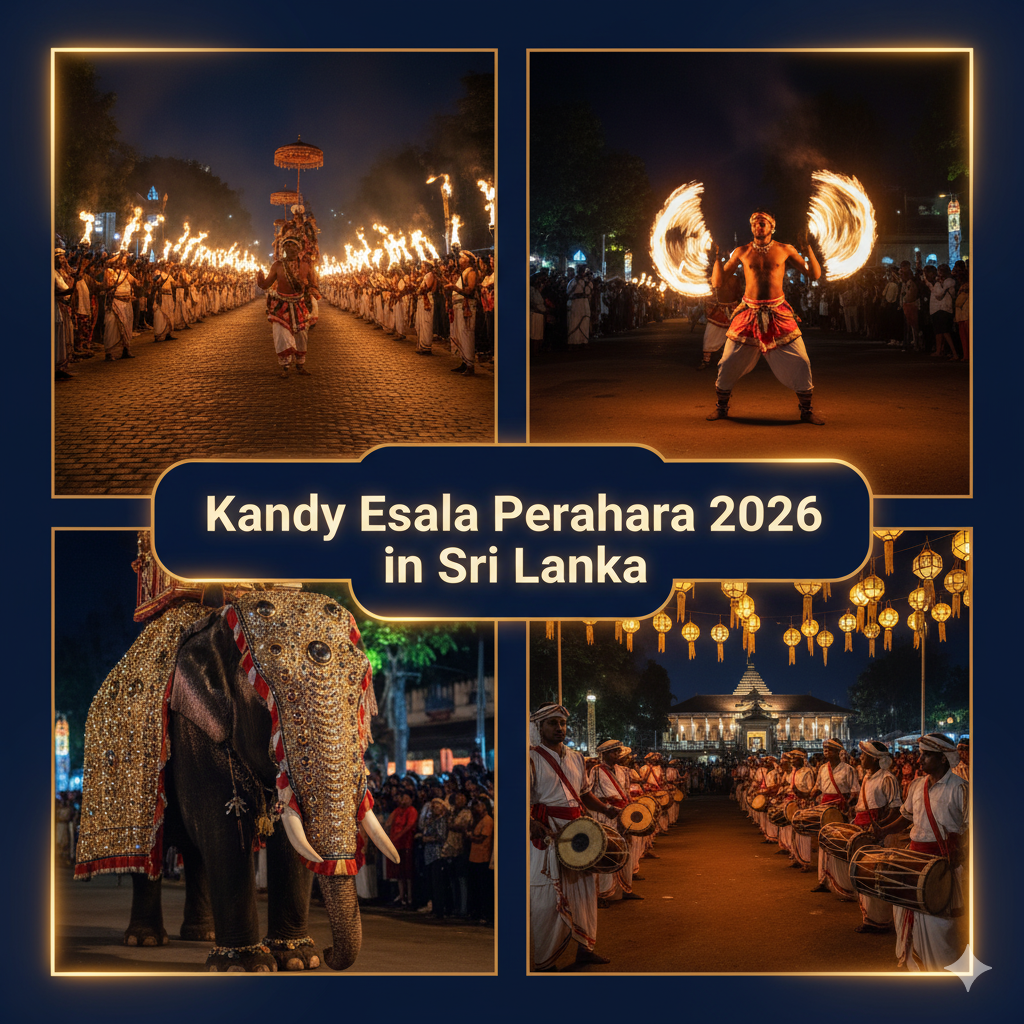The Living Spirit of Sri Lanka’s Grandest Festival
Every year, the heart of Sri Lanka transforms into a dazzling tapestry of color, rhythm, and devotion — welcome to the Kandy Esala Perahera 2026, one of the most magnificent and spiritual processions in the world.
This extraordinary festival, held in the sacred city of Kandy, celebrates the Tooth Relic of Lord Buddha, a revered symbol of Sri Lanka’s cultural and religious identity.
Known for its ornate processions, drummers, dancers, and majestic elephants adorned in glowing attire, the Esala Perahera is more than a festival — it’s a spiritual pilgrimage, a living tradition, and a testament to Sri Lanka’s Buddhist heritage that stretches back centuries.
History of Kandy Esala Perahera: A Tradition Born from Faith
The origins of Esala Perahera trace back over 1,600 years, to the Anuradhapura period, when rulers organized grand parades to honor the gods for rain and fertility.
However, its modern form evolved in Kandy, after the Tooth Relic of Lord Buddha was brought to Sri Lanka in the 4th century AD.
Legend says the relic was smuggled from India by Princess Hemamala and Prince Dantha, hidden in her hair, symbolizing the transfer of divine power and blessings to the island.
Since then, each Sri Lankan monarch has safeguarded the relic, recognizing it as a sacred emblem of sovereignty — and thus, the Esala Perahera became both a spiritual ritual and a royal tradition.
The festival we see today blends ancient Buddhist rituals with Hindu influences, reflecting the island’s multicultural spirit and deep respect for all forms of divinity.
When and Where the Kandy Esala Perahera 2026 Happens
The Kandy Esala Perahera 2026 is expected to take place between August 6 and August 20, 2026, coinciding with the Esala full moon (Poya).
The festival unfolds in Kandy, the cultural capital of Sri Lanka and home to the Temple of the Sacred Tooth Relic (Sri Dalada Maligawa) — a UNESCO World Heritage Site.
For travelers, Kandy becomes a hub of energy, sound, and color, where every evening, streets fill with torch bearers, whip crackers, dancers, and lavishly decorated elephants moving in divine harmony.
The Structure of the Procession: Layers of Meaning and Spectacle
The Esala Perahera isn’t just a parade — it’s a sequence of sacred rituals spanning ten days, each with symbolic depth and aesthetic splendor.
Here’s how the festival unfolds:
1. Kapsituvima – The Planting Ceremony
The beginning marks the planting of a sacred jackfruit tree branch at four temples — Natha, Vishnu, Kataragama, and Pattini — symbolizing fertility and protection.
2. Devale Perahera – Processions of the Four Temples
Each temple begins its own mini procession with drummers, dancers, and priests, setting the rhythm for the main event.
3. Randoli and Kumbal Perahera – The Grand Parades
The highlight of the festival — these processions feature:
- Kandyan dancers and fire twirlers
- Caparisoned elephants carrying sacred relics
- Traditional musicians playing “Geta Bera” drums
- Torchbearers lighting the way for the sacred relic casket
4. The Maligawa Perahera – The Pinnacle of Devotion
The sacred Tooth Relic Casket is carried on the back of the main tusker, known as “Raja”, draped in shimmering gold cloth, surrounded by dancers, monks, and pilgrims.
The Role of Elephants: Symbols of Grace and Strength
Elephants hold a special spiritual status in Sri Lanka, and none more so than during the Esala Perahera.
The “Maligawa Tusker” — the lead elephant carrying the Tooth Relic Casket — is chosen with utmost care, representing purity, wisdom, and serenity.
Each elephant wears illuminated garments, jeweled ornaments, and embroidered capes, creating a sight that leaves onlookers breathless.
This practice also underscores Sri Lanka’s deep bond with nature and animal symbolism, blending reverence with artistry.
Temple of the Sacred Tooth Relic – The Heart of the Celebration
At the core of the Esala Perahera lies the Temple of the Sacred Tooth Relic (Sri Dalada Maligawa) — the spiritual nucleus of Kandy.
Built in the 16th century, this temple houses the most sacred relic in Buddhism — believed to be a tooth of Lord Buddha himself.
During the festival, the relic remains inside the temple, but a replica is paraded through Kandy’s streets as millions gather to receive blessings.
The Cultural Pulse: Music, Dance, and Costumes
Every element of Esala Perahera reflects Sri Lanka’s artistic excellence:
- Kandyan dancers perform rhythmic leaps and acrobatics.
- Drummers create a hypnotic rhythm with traditional instruments like Geta Bera and Davula.
- Torchbearers illuminate the night with oil lamps, forming waves of golden light.
- Costumes feature elaborate beadwork, silk fabrics, and gold-thread embroidery.
It’s a living art form — a fusion of faith and performance that has survived for centuries.
Source:
Travel Guide: How to Attend Kandy Esala Perahera 2026
Getting There:
- Nearest Airport: Bandaranaike International Airport (Colombo)
- From Colombo: 3–4 hour scenic drive or train to Kandy
Where to Stay:
Book early — hotels in Kandy fill fast!
- Luxury: The Grand Kandyan Hotel, Earl’s Regency
- Mid-range: Hotel Suisse, Thilanka Hotel
- Budget: Clock Inn Kandy, The Backpacker’s Nest
Best Viewing Spots:
- Temple Street & Queens Hotel Balcony – for panoramic views
- Trinity College area – for close-up photo opportunities
- Reserved Stands (tickets available online) – comfortable seating with great angles
Entry Tips:
- No entry fee, but tickets for viewing galleries are recommended.
- Dress modestly — shoulders and knees covered as a sign of respect.
- Avoid flash photography near the elephants.
Check Also: Meghalaya Living Root Bridges 2026 – A Natural Wonder Beyond Tourism in India
The Festival’s Global Significance
The Esala Perahera stands alongside events like India’s Kumbh Mela or Thailand’s Loy Krathong, attracting devotees and travelers from across the world.
In 2026, it is expected to draw over 500,000 visitors, contributing to Sri Lanka’s cultural tourism revival post-2025.
UNESCO has also recognized the Esala Perahera as a Masterpiece of the Oral and Intangible Heritage of Humanity, preserving its ancient essence for future generations.
Local Insight: Voices from Kandy Esala Perahera 2026
“We don’t just see the Perahera — we feel it in our hearts. It’s the soul of our city,” says Chathurika Jayasena, a local artisan who prepares costumes for dancers.
“Every drumbeat is a prayer. Every step, a blessing,” shares Ven. Rathana Thero, a monk at Sri Dalada Maligawa.
Their words capture what no photograph can — the emotional power and spiritual depth of this sacred event.
Beyond the Parade: What to See in Kandy
While in Kandy for the festival, explore:
- Royal Botanical Gardens, Peradeniya – serene nature escape
- Kandy Lake – evening strolls with festival lights reflecting in water
- Udawattakele Sanctuary – lush forest walk above the city
- Kandy Viewpoint – perfect for sunset shots of the entire city
A Festival Beyond Time and Faith
The Kandy Esala Perahera 2026 is not just a festival — it’s a living bridge between Sri Lanka’s ancient soul and modern spirit.
It celebrates devotion, discipline, and cultural pride with every step of the parade. For travelers, it’s a breathtaking glimpse into a civilization that still dances in harmony with its gods.
Whether you come for faith, photography, or fascination — this is an experience that will stay with you long after the drums fall silent.



